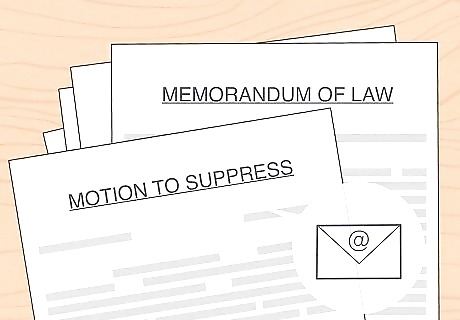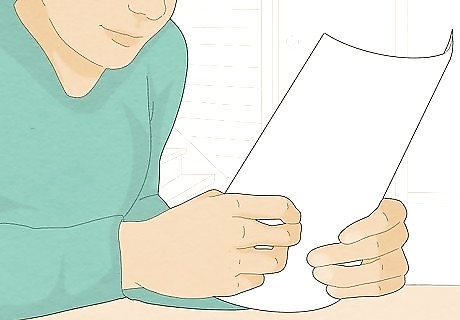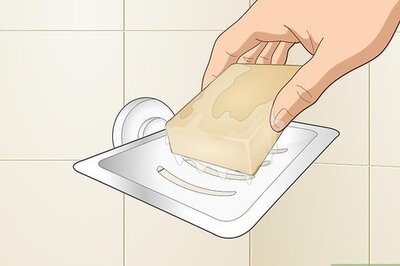
views
Avoiding the Breathalyzer Test During a Police Stop

Avoid risky places and times. Police officers watch for drunk drivers on main roads near bars, concert halls, sports stadiums, and other adult entertainment venues. This is especially true in the late evening and early morning, when people are driving home from a night out. The risk of a DUI conviction is higher in these situations, even if you're within the legal blood alcohol limit.

Cooperate when pulled over. If an officer pulls you over, demonstrate that you are in control and aware of the situation. Turn off the car, turn on the interior light if it is dark out, and put your hands on the steering wheel.

Invoke your fifth amendment right to stay silent. An officer at a traffic stop asks questions to determine whether there is cause to arrest you. Politely tell the officer you wish to invoke your fifth amendment right to not answer any of his or her questions. Do not tell the officer you were heading from a bar or nightclub where alcohol is served. If you lie about the amount and the breathalyzer proves you wrong, it will be difficult to beat the charge.

Ask to talk to an attorney. A small number of states such as New York and Maryland allow you to call an attorney before taking the test. If you take too long to do this, the officer can force you to make a decision: take the test, or refuse. Your attorney can advise you based on the details of your situation. If your state does not allow this, the officer may try to interpret your request as refusal to take the test. If you do not know the relevant law, complying at this point is the safest option. If you were drinking within the last hour, delaying might not help you; your BAC (blood alcohol content) could still be rising. If you were drinking heavily or without food, BAC could rise for two hours after your last drink.

Decline to take field sobriety tests. If an officer asks you to step out of your car, you must comply. However, in most states, you do not have to submit to field sobriety tests, such as standing on one leg or following a pen with your eyes. Ask the officer if field sobriety tests are voluntary and, if their answer is "yes", respectfully decline to take part. Three tests correctly determine sobriety level 90% of the time: following an object with your eyes; walking in a straight line, then turning and walking back; and standing on one leg for thirty seconds. Any other tests could be more subjective, and risky to take even if you're sober.

Make an informed choice about taking the breath test. Every U.S. state has "implied consent" laws, which makes BAC testing mandatory for everyone with a driver's license. Refusal to use the breathalyzer may lead to harsher penalties than a first-time DUI offense. Unfortunately, the "implied consent" law allows the prosecutor to use your refusal as evidence against you in court. If there are any other signs of intoxication, you could be charged with DUI anyway in addition to those penalties. There are some situations where refusal is worth considering, but rarely correct: If you are under the age of 21, you should be aware that the blood alcohol content limit only applies to those of legal drinking age (21 and over). Most states do not allow you to have a blood alcohol content (BAC) higher than .01% or any amount. This is called the "zero tolerance law" and it is designed to discourage underage drinking. Commercial drivers who are over 21 have a lower blood alcohol content limit while operating commercial motor vehicles. You can refuse the roadside test (preliminary breath test or "PBT") with less severe consequences, but there's not much point. The result cannot be used in court, and refusal will not prevent the officer taking you to the station. If the officer has no reasonable grounds to think you are drunk, you could refuse, then challenge the ruling in court to reverse your punishment. The odds are not in your favor with this option. If you are extremely drunk, you could be charged under your state's "aggravated DUI" law for a very high BAC (the cutoff is between 0.15 and 0.18 in most states). The severe legal consequences for refusing the test may still be milder than an aggravated DUI conviction.
Improving Your Chances of Passing

Hyperventilate. Breathing rapidly and forcefully before exhaling can reduce the results by 11%, which could save you if you're just above the legal limit. This probably works by raising the air temperature in your mouth, which affects how much alcohol it picks up.

Taper off early. As you blow into the device, taper off your breath early. Some roadside breath testers trigger to take the sample as the flow decreases, on the theory that this comes from the deepest part of your lungs. By ending your breath early, you can lower the results. This works best if you have a large lung capacity, since there is a minimum volume of air required. For most tests, you will need to expel roughly 30% of your maximum exhale (for men) or 40% (for women).

Do your best to trigger the machine. If the breathalyzer does not get a reading from your first couple attempts, stop trying to trick it. The officer may consider this a refusal to comply, which can lead to a DUI conviction with additional consequences.
Fighting the Breathalyzer Results in Court

Hire a lawyer. Even if you were arrested for failing the breathalyzer test, you get a chance to defend yourself from the charges. As soon as you are released from jail, usually within 24 hours, find a criminal defense lawyer. Many communities have lawyers whose practice focuses solely on DUI charges. If your friends and family cannot recommend any good lawyers, contact your state bar association's lawyer referral service. After answering a few questions, the service will direct you to various lawyers in your area.

Draft a motion to suppress evidence. Talk to your lawyer about the possibility of suppressing the breathalyzer results from court, removing them as evidence. To do this, you'll need to persuade the judge that the police gathered the evidence improperly. If you do not have a lawyer, draft the pretrial motion yourself using examples from a law library or law firm website. These motions typically start in the following format: A caption listing the court, parties involved, case number, and judge. Ask the court staff for the correct format. Title, such as "Motion to Suppress." A paragraph identifying yourself, your request, and the law allowing it. For example, "I, Jane Smith, the defendant in this case, respectfully ask that, pursuant to [cite law], you suppress the results of the breathalyzer test in this case. This motion is based on the following statement of facts and as grounds in support thereof."

Attach an affidavit laying out the factual basis for your motion. Your motion must include an affidavit (a sworn statement) that lays out all the facts you are using to support your motion. You will personally sign this affidavit because you are the one with personal knowledge of the facts. List the facts in individually numbered sentences. Only include legally relevant information. For example, state whether you were informed of implied consent, how long the officer observed you before administering the breathalyzer, and whether the officer complied with proper breathalyzer procedures. Your lawyer can request maintenance and calibration records for the device. If the device has not been properly maintained, note this fact.

Draft a memorandum of law. This document will lay out your legal arguments for why the breathalyzer test should be suppressed. In most breathalyzer test suppression motions, you will have to indicate that a breathalyzer test is a search under the Fourth Amendment, that the search in this instance was performed unlawfully (e.g., the officer did not follow the necessary procedures before administering the breath test), and that, under the exclusionary rule, evidence obtained unlawfully should be excluded. This is where your lawyer will really help your case. This memorandum of law will include legal arguments and citations to court cases and statutes.

Serve the prosecution. Before you file your motion with the court, send a copy of the motion and all the attachments to the prosecutor's. It is usually not necessary to serve these papers personally.

File your original motion paperwork. Once the prosecution has been served, file your motion with the clerk of court. In most cases, this just means handing the paperwork to the clerk. File the motion to suppress before the trial date has been set if you can. Some states allow you to file a motion within a certain number of days after the trial date has been set (e.g. 21 days in Massachusetts).

Schedule a hearing. At the same time you file your motion, ask the clerk to have a hearing scheduled. A hearing will give you and your lawyer an opportunity to argue your case for suppression in live court in front of a judge. Some courts will schedule a hearing for you, other courts will hear the motion at the next scheduled court date, and others will ask you to find a date that works for all parties.

Read any responsive motion from the prosecution. Before your hearing, the prosecution will have an opportunity to file their own responsive motion and memorandum of law disputing your findings. If the prosecution decides to file a response, you will be served with a copy before the hearing date. Read this document carefully, as it will provide insight into how the prosecution plans to attack your motion.

Attend the hearing. Arrive early and let your lawyer do the talking. Once both sides have made their argument and counterargument, the judge will decide whether to grant or deny your motion. If your motion is granted, the court will suppress the breathalyzer test results and the prosecution will not be able to use this evidence against you. If your motion is denied, your lawyer may still attempt to discredit the breathalyzer results during the trial itself.



















Comments
0 comment